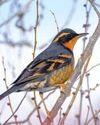
Then, as a resident on the west side of the Cascades, the bird was new to me and my friend walked me through the ID process.
I leaned out the car window and snapped a few photos of the bird as it hopped around on the ground. As we prepared to move on, I reviewed the images on the camera’s LCD screen and showed them to my friend. His comment was, “Maybe we can find some that aren’t standing on cow pies.” Good idea.
I’ve learned since then that Horned Larks seem to prefer open areas such as plowed or stubble wheat fields or areas with short grass. The Audubon field guide says that they do well on overgrazed or abused land, which there is plenty of throughout the West.
Even though they are widespread in the continental United States and Canada, Horned Lark populations are in steep decline. The North American Breeding Bird Survey estimates a decline of 71 percent between 1966 and 2015.
Esta historia es de la edición November 2020 de The Good Life.
Comience su prueba gratuita de Magzter GOLD de 7 días para acceder a miles de historias premium seleccionadas y a más de 9,000 revistas y periódicos.
Ya eres suscriptor ? Conectar
Esta historia es de la edición November 2020 de The Good Life.
Comience su prueba gratuita de Magzter GOLD de 7 días para acceder a miles de historias premium seleccionadas y a más de 9,000 revistas y periódicos.
Ya eres suscriptor? Conectar

Nita Paine
‘I love that we provide an outlet to people to express themselves, to find out who they are’

Looking at life from a different angle now
Bout with cancer, plus pandemic made couple wonder: Why wait to really live?

Keeping family ties strong
Twelve months of COVID makes for a long year away from kids and grandkids

It's a kick to be a zebra — or a canary
When making the call is your calling

Saved family letters tell of war horrors, peacetime hopes and dreams
Loving letters from long ago

Varied Thrush: Making a bold statement
Globally, the thrush family contains 169 viable species; three other thrush species are now extinct.

Clean shots
For real estate photographer, the art is in the uncluttered details

Visiting the glory years of our parents
Obituaries – They’re really NOT for the dead

Going deep with Dan Feil
Warm crystal clear water, incredible fish, spectacular scenery, why not jump off a boat in the tropics?

Bringing a glow to the night
Who says outside lights are just for Christmas time? Drivers on Maple Street in Wenatchee will now see lights year-round.